Michael McFadyen's Scuba Diving - SS John Penn
And the rockets' red glare, the bombs bursting in air
Gave proof thro' the night that our flag was still there...
And where is that band who so vauntingly swore
That the havoc of war and the battle's confusion,
A home and a country should leave us no more?
Their blood has wash'd out their foul footsteps' pollution.
Francis Scott Key
The Star-Spangled Banner
The USS John Penn started its life as the SS Excambion. Built in 1931 as one of four identical vessels by the New York Shipbuilding Company, Camden, New Jersey, for the Export Steam Ship Corporation (founded 1919). As well as the SS Excambion, the new ships were the SS Exeter, SS Excalibur and SS Excochorda. Collectively they were known as the "Four Aces".
The Excambion displaced 9,360 tons and was 450 feet long. In 1938 the Export Steam Ship Corporation became the American Export Line. The following history of the ship is partly based on a report in the Dictionary of American Naval Fighting Ships, Vol. III 1963 Edition pp. 541-542, published by the U.S. Navy Historical Center.
The new ship (as well as her sisterships) were used on the New York to Mediterranean run and provided a regular service. The ships served New York, Gibraltar, Marseilles, Genoa, Leghorn, Naples, Alexandria, Jaffa, Heifa and Beirut. The trips were advertised as "Yankee Cruises De luxe to the entire Mediterranean". They were said to be "Staunch, Steady and Sturdy".
 |  |
| SS Excambion | Another photo of SS Excambion |
On Tuesday 3 August 1937 SS Excambion departed New York on a "Yankee Cruise". Captain William W. Kuhne was the skipper. The first port was Ponta Delgada in the Azores which was reached on Monday 9 August 1937. From here it went to Gibraltar arriving Thursday 12 August 1937. While only 30 minutes was spent at Gibraltar, in Ponta Delgada they had a day's tour.
From here the ship went to Marseilles, France, arriving Saturday 14 August 1937. I presume it stayed here for the daylight hours before moving onto Naples, Italy which it arrived at the next morning, Sunday 15 August 1937. Here some of the passengers took a "Thomas Cook" trip to Pompei, Amalfi and Sorrento.
On Friday 20 August 1937 the Excambion arrived in Alexandria, Egypt. The next morning, Saturday 21 August 1937, some passengers from the SS Excambion, (again using Thomas Cook), take an overland excursion from Alexandria to Jerusalem in what was then British Controlled Palestine and is now Israel. The next day (Sunday 22 August 1937), they went from Jerusalem to Bethlehem, Galilee and Tiberius in British Occupied Palestine and then to Damascus in French Occupied Syria.
 | 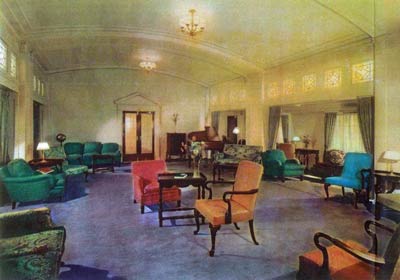 |
| The Main Reception on SS Excambion | The Lounge on the SS Excambion |
On Monday 23 August 1937 they travel from Damascus to Baalbek and Beirut in French Occupied Lebanon. I think that the ship met them in Beirut and they then sailed on Tuesday 24 August 1937 back to Alexandria. On Wednesday 25 August 1937 the ship arrived back in the Port of Alexandria, Egypt. I am not sure what they did the next day but on Friday 27 August 1937 the passengers went to Cairo (presumably also the pyramids) and then the ship departed Alexandria for Pireas (Athens), Greece. The Excambion arrived there on Saturday 28 August 1937.
On Sunday 29 August 1937 the ship arrived at Naples, Italy for the second time on the journey. The next day, Monday 30 August 1937 they arrive at Rome, Italy. On the Tuesday 31 August 1937 some passengers did a tour of Rome. That evening, the ship departed Rome.
On Thursday 2 September 2, 1937 the Excambion arrived at Genoa, Italy and on the next morning arrived at Marseilles, France for the second time. On
Monday 13 September 1937 she arrived in Boston, Massachusetts. The ship was supposed to leave that night for New York but a strike by the port workers delayed the sailing till 4 pm on Tuesday 14 September 1937. However, it did not depart till Wednesday 15 September 1937. The next morning, Thursday 16 September 1937, the Excambion arrived in New York harbour.
 | 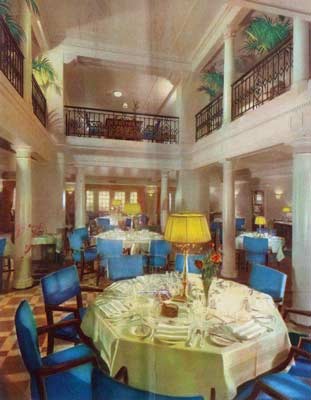 |
| The Smoking Room on SS Excambion | The Dining Room on SS Excambion |
In November 1940 the Excambion exacuated adults and children refugees from Nazi persecution. They boarded the ship in Lisbon (this may have now been a regular stop) and travelled to New York. Also in 1940 (perhaps on the same trip), the ship carried the famous artist Salvador Dali and his wife as they fleed France for the US. The ship also sailed from Lisbon to New York, arriving 24 November 1941 (information from Carolyn Bausinger whose Dad was on the ship - he was returning from working at the US Embassy in London).
The SS Excambion was acquired by the US Navy on 8 January 1942 and renamed USS John Penn. She was commissioned as Naval Transport AP-51 on 6 April 1942 with Captain Harry W. Need in command. I had originally presumed that like the TSS John Penn now wrecked in New South Wales, Australia, it had been named after the famous naval architect, John Penn. However, this is incorrect. The ship was actually named after one of the United States' earliest patriots.
John Penn was born in Caroline County, Virginia, USA, in 1740. He became a lawyer at twenty-one. At twenty-three, on July 28, 1763, he married Susannah Lyme. The couple took up residence in Williamsboro, North Carolina and Penn entered politics. In 1775 he was elected to the provincial congress and the Continental Congress. A committed revolutionary, he wrote to his close friend Thomas Person:
"For God's sake, my Good Sir, encourage our People,
animate them to dare even to die for their country."
He voted for and signed the Declaration of Independence, serving in the Congress until 1780. His character may be discerned by his conduct in an unusual affair of honor. Henry Laurens, President of Congress, challenged him to a duel. Since they were boarding at the same inn, they had breakfast together on the appointed morning. They started out together for the "field of honor", but after Penn had assisted his elderly opponent across a terribly muddy street, he suggested that they forget their quarrel. Laurens agreed. After the Revolution, Penn returned to the practice of law until his death in 1788.
As I indicated above, the USS John Penn was commissioned 6 April 1942 with Captain Harry W. Need in command. After fitting out and training, the John Penn began preparations for what was to be one of the largest overseas expeditions ever undertaken: the North African Invasion.
From 4 to 16 October 1942, John Penn loaded Army equipment, cargo and troops at Norfolk Virginia and topped off with fuel. She sortied from Hampton Roads on 23 October 1942 with Admiral Hewitt's Western Naval task Force. As a unit of Rear Admiral Monroe Kelly's Northern Attack Group, she arrived 8 November 1942 in the transport area off Mehdia, Western Morocco where she began landing troops and putting cargo ashore. Although hampered by heavy surf and fire from enemy shore batteries, she unloaded with efficiency and dispatch. At 1053 an enemy aircraft attacked the John Penn (a Vichy French P-36) but her aft-batteries splashed the intruder. On 15 November 1942 she departed for Casablanca, arriving that same day and unloaded the remainder of her cargo. She sailed for Norfolk 17 November 1942 arriving on 30 November 1942.
The John Penn departed Norfolk, Virginia, on 17 December 1942 for deployment to the Pacific, arriving in New Caledonia via the (Panama) Canal Zone on 18 January 1943. She was carrying a load of Sea Bees and their construction equipment (personal comment by E. Wallace Haynes - see references).
She departed New Caledonia on 24 January 1943, touching at Espiritu Santo. Three days later, she got underway to pick up survivors from the cruiser USS Chicago, sunk off Guadalcanal on 29 January 1943. In all she rescued 1,003 men and 63 officers, including Captain R.C. Davis, the lost cruiser's commanding officer. After debarking her grateful passengers at Noumea, New Caledonia, she spent the next six months delivering supplies, equipment and troops to Guadalcanal from the New Hebrides [now Vanuatu], the Fiji islands and New Zealand. Reclassified as an Attack Transport (now APA-23) on 1 February 1943, she continued to bring supplies and troops into this bitterly contested island.
 | 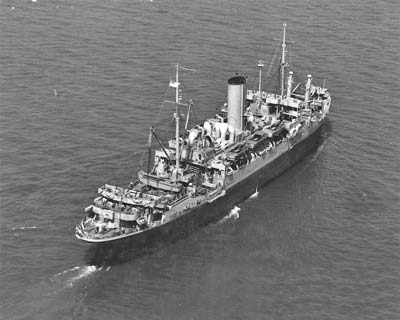 |
USS John Penn on 13 September 1942
National Archives 80-G-10874
The wreck of the Japanese plane is located in
the dark spot to left of bridge near main deck | Another shot of USS John Penn on 13 September 1942
National Archives 80-G-10873 |
On one trip to Noumea in New Caledonia (perhaps the first and only one), a new jeep was collected at the Army Base by E. Wallace Haynes, MoMM First Class. He brought it back to the John Penn and it was loaded aboard. On board the ship was a Commodore, perhaps by the name of Anderson. This jeep was for his use. When the John Penn was in New Zealand collecting supplies, Mr Haynes drove Commodore Anderson around in the jeep.
On the evening of Friday 13 August 1943 the USS John Penn had just completed unloading its cargo of supplies off Henderson Field, the main airfield of Guadalcanal, when it and other nearby vessels were attacked by Japanese torpedo planes. The planes were Nakajima B5N2 Kate torpedo bombers that had left Southern Bougainville between 1845 and 1900. There were seven planes, two of which were carrying flares and bombs while the others had torpedoes.
The planes were sighted by radar at 2020 and the alarm was raised on the John Penn. However, after a considerable period had passed, no real action had been seen except for some bombs dropped from height on Lunnga Point and the nearby sea and some flares dropping from nowhere.
Charles Flanner was a Pharmacist 1st Mate on the USS John Penn from the time she was commissioned. As well as this role, he was assigned additional duties above a Pharmacist Mate. He was assigned to man one of the deck guns, from the description he gave his daughter it sounds like an anti-aircraft gun. He was also assigned to drive one of the landing craft running troops and supplies to and from shore
On the evening of Friday 13 August 1943 Charles and another sailor were returning to the ship from shore (either dropping off supplies or picking them up). They were still a distance from the ship when they saw her being attacked.
Just after 2110, all hell broke loose as when a supporting destroyer started firing at a low flying aircraft (however, see later comments by O. E. Manning about high flying aircraft). Two more destroyers started firing at different planes, all converging on the John Penn. The first plane attacked from the direction of Tulagi, towards the starboard side amidships. The plane was 50 feet off the water and was under tremendous attack from not only the John Penn, but USS Fuller as well. At the same time, another plane was attacking from direction of the bow. When 150 to 200 metres away, it dropped a torpedo, although the Dictionary of American Naval Fighting Ships mentioned above says 50 yards. More about this later.
A third plane also attacked at the same time. Two reports [from the above mentioned book and Ewan M. Stevenson (see references)] says that when the transport took one of the planes under fire while attacking the stern, it burst into flames and crashed into her mainmast or aft section. However, this is not mentioned in another source.
In December 2000 I was e-mailed by E. Wallace Haynes, MoMM First Class, who was a member of the John Penn until the day it was sunk. He told me:
I was a fireman member of a Higgins boat landing craft for several trips in the South Pacific but had progressed to MoMM 2.c when she went down. I was a lookout on the port flying bridge when the plane crashed [into] the superstructure and the torpedo hit the ammunition magazine, abandoned ship starboard side bow, picked up by a boat crew from the Island boat pool and spent the night in a fox hole. Next day the Hunter Liggett took some survivors to Noumea. Fourteen days was aboard the SS President Jackson.
In October 1999, a friend of mine, Jason McHattan, had a look at this page and sent me the following e-mail in response to the paragraph before the one above:
When I was there in 94 I discovered the wreckage of a Japanese aircraft, which I believe to be a 'Kate', at the intersection of the deck and bridge, on the sand at about 60m. Upon surfacing and telling the local operators about it, they said that they'd read the reports of an aircraft hit, but neither they nor anyone else had ever seen it. Kevin Denlay went in but couldn't find it, so the operator then dived and confirmed my find... Also, when I dived it in 95 I found a Jeep on the sand nearby, also previously unknown. If you go out from the bridge, (which collapsed late in 95), the Jeep is sitting upright about twenty metres from the wreck. I don't know if the bridge has collapsed onto the aircraft remains which consisted of the entire tail section from about three feet forward of the vertical stabiliser, and an oleo strut (wheel leg).
 |
The jeep on the sand next to USS John Penn
Photo taken by Neil Vincent and used with his permission
|
The jeep was obviously the one collected by Mr Haynes in Noumea and used in New Zealand.
Anyhow, at 2123 hours (9.23 pm) the John Penn was struck by the torpedo on its starboard side, either amidships or towards the stern at hold five. It was also alleged to have strafed by this and the other aircraft. However, Mr Haynes has told me that the ship was not strafed but was hit by gun fire from a US destroyer which was using a radar controlled gun to shoot down the torpedo plane. The Penn was rocked by two or three explosions, the first being the torpedo and the second the ship's after magazine in hold five.
The third may have been the plane hitting the ship. The torpedo and subsequent explosions caused considerable damage to the ship. A large hole was torn in the starboard side, a fire started in the after holds, the after gun platforms were blown towards the stern and the main mast and 30 ton boom were thrown about the upper deck (this was possibly from the plane hitting the mast). All engine and electrical power was lost and the watertight compartments aft were observed to be filling with water. At 2133 (10 minutes after the attack) there was only three inches of freeboard aft and orders were given to abandon ship. At 2150 the USS John Penn disappeared from view and became another casualty of the Battle of Guadalcanal.
Of the crew of the ship and the marines on board unloading the cargo, 98 were dead or missing.
As you will recall from above, as the ship was being attacked, Charles Flanner was driving his landing craft back to the ship. Much later he told his daughter of rescuing sailors from the ocean after the ship had been destroyed. Many were severely burned and injured. He said that it left an emotional impression on him. It sounded like they picked up several hundred in total. After this he was reassigned to shore duty as a Pharmacist Mate for the remainder of the war.
As the ship was sinking, USS APc-25, a small 100 ton coastal transport ship was quickly on the scene. This was under the command of Lieutenant John D. Cartano. Approximately 35 sailors were rescued, with some of the crew of USS APc-25 diving overboard to assist the survivors. Some of the worst injured were transferred to Higgins boats which had come from the shore. One of the crew of USS APc-25 was Donald Gepford. He received a Citation for Rescue Work from Lt Cartano on 22 August 1943 for "materially assisting in the rescue of over 35 men ... while there was substantial danger from exploding boilers, exploding ammunition and magazines, and considerable danger from burning oil on the waters".
George Parker was 18 years old and a crew member of the John Penn. He e-mailed me in November 1999 when he was 75 years old. This is what he told me:
I enjoyed reading your article about the USS John Penn [sic] at Guadalcanal. I was a seaman 1st class on the number 1 gun on the bow. I was on board when the ship was hit. Your article is pretty accurate as far as I remember although I do not recall being strafed by an aircraft. I remember the torpedoes and the plane hitting just forward the bridge. I don't remember the plane strafing us, although it could have. There was much confusion. ... I appreciate your article - it is the most detailed and informative I've seen yet.
Therefore, from the above three first hand reports, it is quite obvious that the ship was hit by a Japanese plane that contributed to its sinking.
The following is a report by CM1 James J. Altemueller, USN, who was a crew member of the USS John Penn. It was sent to me by his son John S. Altemueller.
Since I was an experienced master carpenter (my father was a builder) I was detailed from the Penn to Tulagi to work on the landing craft at the amphib boatyard. General Vandegrift (CO of the 1st Marine Division, the first on Guadalcanal) had the idea to create these boat pools so there would be enough seaworthy landing craft for the jarheads [slang for marines] to use for their assaults. The Japanese sent bombers down from Rabaul (on New Britain) pretty regular to tear things up, but our fighters from Henderson Field (on Guadalcanal) swarmed up like hornets to hit them.There was something sweet about the sound of those engines on the Grumman fighters (Marine F4F's) [Wildcats]. Like a bulldog's snarl. Didn't have to see them.You knew right away they were ours. With the enemy planes it was different. One bomber-we called him "Washing Machine Charley" - had his engines desynchronized so they made a hell of a racket when he came over at night. He dropped a bomb or two, mainly just to keep us awake and on edge. I found out later that Charley had the bad luck to fly home one night just as our planes were finishing an air raid on his base. He got caught in the searchlights and was shot out of the sky by his own antiaircraft. That was the end of Charley. We got the word that the Penn was gone the evening of the 13th [the night it was sunk]. Sailors get attached to their ships. She becomes your home after a while, especially after all we'd been through in North Africa and here in the Solomons. We'd lost friends and shipmates and our home - that was a terrible feeling.
O. E. "Shy" Manning emailed me on 17 July 2006 when he was 85 years old. He is from Oklahoma City, Oklahoma. The following is what he told me:
I just wanted to tell you how much I enjoyed reading your website on the John Penn. I had not seen a picture of the John Penn before finding your website. It brought back lots of memories. I am 85 years old and living in Oklahoma City, Oklahoma. I was a F1C when I was assigned to the John Penn in March, 1943 in Noumea, New Caledonia. I was sitting on the fan tail when GQ sounded and I saw the Jap bombers with the search light on them. The red flairs shot off and our planes did not land. I also heard that these two Jap planes came with our planes as if they were ours. They went out to sea and came back in very low and laid the torpedo more to mid-ship. I stayed top side for a few minutes before going to my GQ station, which was one deck above the engine room. When the torpedo hit the officers told us to go top side because of lack of power and communication. We were told to abandon ship. I went down a rope and swam out about the length of one block before a boat picked me up. In the boat was the chief engineer, he had been burned by live steam and was in very bad condition. There was a doctor aboard, but he had a broken leg. My only injury was a rope burn to my hand. I spent the night on the beach and a ship came by and picked us up the next morning and took us to Noumea for reassignment. I was then assigned to the President Adam APA 22.
I found your article to be very accurate with my memories. I am attaching a newspaper clipping from the "Daily Oklahoman". I included the backside of the article since it had the date.
The only item of value that I lost on the ship was my high school class ring. It was in my locker. So, if you find it you now know where I am! Ha!
As indicated, Mr Manning sent me a clipping from the Daily Oklahoman dated 30 September 1943. This shows that the US Government released details of the sinking on 24 September 1943. This shows that high flying Japanese bombers attacked first, drawing fire from all the Allied warships while torpedo bombers came in low. The report also says that some US aircraft were attacked by the warships when they overflew during the attacks. One of the Japanese bombers was apparently destroyed.
 |  |  |
One of the holes ripped in the bottom
and side of the hull by the ammunition | A large winch on the forward
deck (now vertical) of the ship | Swimming through the superstructure
of the USS John Penn |
On 18 February 2018, Nancy Renna from New Jersey, emailed me as follows:
My father, Pete Renna, was assigned to the John Penn when it was torpedoed. He happened to be on the transport boat loading/unloading the ship at the time of the attack. His hand was inches from grabbing the hook of the Penn to secure their boat when the torpedo hit. They pushed away from the Penn and got to safety. He grew a bond with his shipmates while on board but never knew who survived.
When I found your website, I emailed Wallace Haynes who was mentioned in your website and explained the story to him. He was excited to hear about my father and they connected via telephone. That is all my father needed. He was content to find one shipmate.
My father passed at the age of 91 in 2016.
Today the USS John Penn lies on the bottom of Iron Bottom Sound on its starboard side. I had been told that it was discovered in 1972 by Australian Wally Gibbins and the Chief Fisheries Officer for the Solomon Islands, Dick James and that Wally Gibbins, Mike Laurent and Gary Dalton salvaged the bonze spare propeller (16.25 tons, 18.25 feet diameter). They discovered that the ship was in two pieces, the stern not yet found. The spare prop was located on the back wall of the forward section of the ship.
On 16 June 2003, Gary Dalton e-mailed me and told me that he had a salvage boat and he was salvaging ships in the South Pacific and ended up in the Solomon Islands. Mike Laurent and Wally Gibbins had the salvage rights but there was only about six or seven months to left. Mike went back to Australia and Wally turned more to spearfishing and collecting shells (I presume armament shells not animal kind).
Most of the bronze had been collected so Gary went looking for new stuff. He was working the area off the Lunga River/Red Beach area, dropping small charges to free oil contained in equipment that he thought had been dumped from a large gas tanker that had blown up there. He went well off shore and one of his charges created an oil slick. He was crossing back over the slick when the depth sounder showed a huge school of fish and then, a huge wreck. This was the USS John Penn and he did a dive on it even though it was almost dark.
He spent three months salvaging the wreck and reported that there were nearly always very strong currents and nearby, lots of sharks. He found the stern section about 1/4 mile (say 400 metres) behind and in line with the wreck. This had the prop shaft and propeller. He salvaged three of the four blades. He told me that he got bent putting charges on the prop, doing two bounce dives to 236 feet (about 72 metres) with only a total bottom time of three minutes. Gary got to the surface and was totally paralysed so Wally Gibbins put him back in the water (hitting him on the head in the process with an anchor used to get him down - he still has the dent in his head).
In 1973, Brian Bailey did some more salvage work on the condenser, but had an accident when part of the wreckage fell on him, knocking the hookah hose out of his mouth. Luckily he was wearing scuba as well and this saved him as the plate hit the tank rather than his body. He used the tank, slipped out of the harness, regained the hookah hose and then released the tank. This was apparently the end of the salvage.
When I dived the wreck in 1992, a mooring line was attached to a field gun which was sitting on the rear port hull. I assume that at sometime it was partially salvaged and placed here, but for what reason I do not know. As I indicated above, the stern of the ship is separated from the main section of the wreck but I cannot attest to this as on my one dive we only went to the bow area. The explosion in the after compartment obviously was devastating.
The John Penn is located off Lunga Point and is affected by the tidal currents. Apparently you can only dive here on the top or bottom of the tide. The visibility as you descend is not very good, especially when compared to other Solomon Island dives. Maximum visibility when I dived was of the order of 8 to 10 metres and the water a little cooler than normal at 25 degrees. A fairly thick layer of silt covers the entire wreck. However, when speaking to Brian Bailey in late September 2009 at the Point Cruz Yacht Club, he had visibility of over 25 metres on a number of dives on the wreck that week.
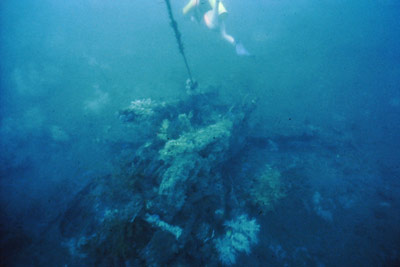 | 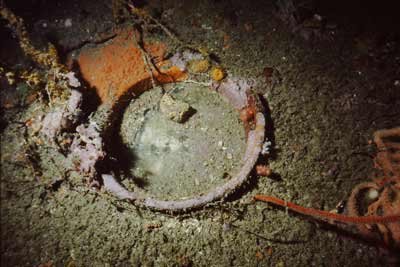 |
| The field gun on the hull of the wreck -1992 | One of the many portholes visible on the wreck - 1992 |
The shallowest part of the wreck is the port hull which is about 36 metres and there are plenty of portholes to examine. As well, there are a number of medium sized holes which appear to have been caused by internal explosions, probably the ammunition in the after magazine.
A short swim brings you to the upper deck of the vessel and you drop over into the dark void. There is plenty to see here, including the bridge, holds, forward gun and derricks, masts and winches. On my only dive on the vessel, we went to 48 metres looking at the forward hold and gun. We also penetrated a short distance into the medical area where we saw bed pans and drug vials. The sand below the John Penn is about 56 metres.
This is a large ship and the one dive I did was not enough to properly examine it. A number of dives would be required to get a good feel of the ship and a guide is essential.
The USS John Penn is an excellent shipwreck for the experienced deep diver. I would encourage such divers to dive the wreck on their visit to Honiara.
In her naval service, the transport had played a key role in the assault and occupation of French Morocco and contributed greatly to the struggle for Guadalcanal. She certainly lived up to the ideals of the patriot John Penn and did not let his great name down. In war there are always losses, but John Penn's crew, reassigned to other ships, took part in later decisive naval victories.
SS John Penn received one battle star for World War II service.
NOTES:
Photographs taken with Nikonos IV-A in 1992. The last two photos were scanned in 2011, the others back in about 1993.
After the loss of the John Penn, a new Liberty ship was named USS John Penn in honour of the fallen ship.
References:
| 
 v6.00.307 © 2003-2005
v6.00.307 © 2003-2005